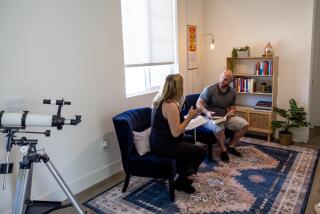Factory-Home Owners Fit All Types
There is no stereotype for buyers of the somewhat maligned manufactured home.
Increasingly, large numbers of would-be home buyers, regardless of age, are turning to the mobile home as their chosen dwelling. More than 200,000--a third of all new homes sold annually--are now built in a factory.
Unable to fit into the home purchase affordability index--which in California means only 24% are able to buy the $172,347 median-priced, single-family home--the young, middle-aged and seniors are increasing the market share of the manufactured home.
The three factors attracting buyers and increasing sales from among those three groups are price, low maintenance and lower upkeep.
The leading insurer of manufactured housing, Foremost Insurance Group of Grand Rapids, Mich., reports that a nationwide survey among 16,568 owners of factory-built homes cannot be easily categorized, that there is no typical buyer.
But these homes offer such options as a starter home for the young buyers, a “move-up” for some buyers and a low-maintenance dwelling for retirees.
The 1987 survey showed that nearly half of the owners of manufactured homes previously owned site-built houses. Another 25% had lived in a different manufactured home, while 18% had rented an apartment or townhouse. Another 10% had lived with their parents.
Nationwide, but not here, of course, the average purchase price reported for used and new manufactured homes was only $14,346, up $1,304 from a 1984 survey.
American 21st Century Homes, based in Acton, just south of Palmdale, is a rapidly growing recent entrant in the field, offering customized manufactured homes of about 2,000 square feet for $90,000 and up, exclusive of the lot. The homes are built by Silvercrest Manufactured Housing Inc., the state’s fourth largest manufactured-home builder, based in Corona.
Formed in 1986 by British-born David T. Maddock, American 21st has sold more than 200 “affordable reality” units, claiming a whopping growth rate of 843% since its inception.
Craig Fleming, vice president of sales and marketing for Silvercrest, concedes that despite the success of American 21st Homes, buyer resistance is still a major factor in the manufactured-housing field, “based on the stereotype of a mobile home in a trailer park at the edge of town.”
He adds, however, that “the days of the long, long trailer are over. Buyers are beginning to realize that you can put an on-site frame home next to a manufactured home, and the manufactured home will look better and is much more cost effective.”
The survey, conducted by National Family Opinion Inc., which describes itself as the nation’s largest mail consumer panel research facility, found that 87% of the respondents were satisfied with their manufactured home; just over half described themselves as “very satisfied.”
Their average age was 47. Owners between the ages of 30 and 49 are increasing, while the segment of owners 60 and older has dropped by 30% since the 1984 survey.
The average owner has lived in the same unit for 9.3 years; 42% have lived in a manufactured home for a decade or longer, and more than half plan to stay put indefinitely. More than half are blue-collar workers or retirees.
Median income is $17,500, up from $14,500 in 1981, and $16,000 in 1984. In the last three years, the number of households with incomes greater than $30,000 rose from 14% to 17%.
Thirty-one percent have attended or completed college and 75% of the heads of household have completed high school.
Most households include a married couple (62%), a drop from 66% in 1984. Divorced and widowed women make up the next largest segment, 24%.
The average family size is 2.5 members, and single-person households make up 24% of the total. Two-member households account for 34%, three-person for 18%, four-person for 15% and five or more for 8%.
Compared to 49% of those surveyed in 1984 whose manufactured dwellings were sited on property owned by the dweller or a relative or friend, the latest figure is 54%. Forty percent now live in tenant parks, down from 44% in the previous study.
Single-wide units made up 80% of the home size, double-wide represented 19% and triple wide, only 1%. The latter figure is unchanged from 1984, while the other two categories each increased by 2%.
Occupations of household heads ranged from retired, 26%; operator/laborer, 18%; student/armed forces, 15%; technical/sales and administrative support, 12%; craftsman/repairman, 11%; managerial/professional, 8%; service, 7%; farming/forestry/fishing, 3%.
The major drawback cited by owners? If you’re a pack rat, look elsewhere.
More to Read
Inside the business of entertainment
The Wide Shot brings you news, analysis and insights on everything from streaming wars to production — and what it all means for the future.
You may occasionally receive promotional content from the Los Angeles Times.










